A common question we get asked is what products we use and recommend to our friends and family. We have compiled a list of our staff’s favorite products, and how they changed our skin! And we are excited to introduce a few members of our Appearance Center team.
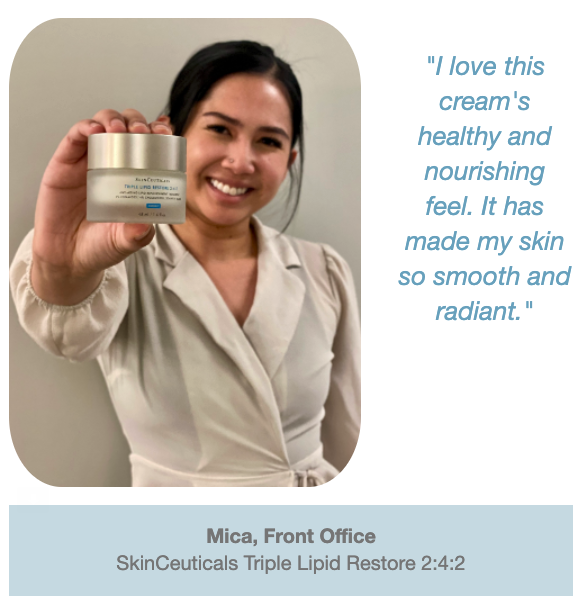
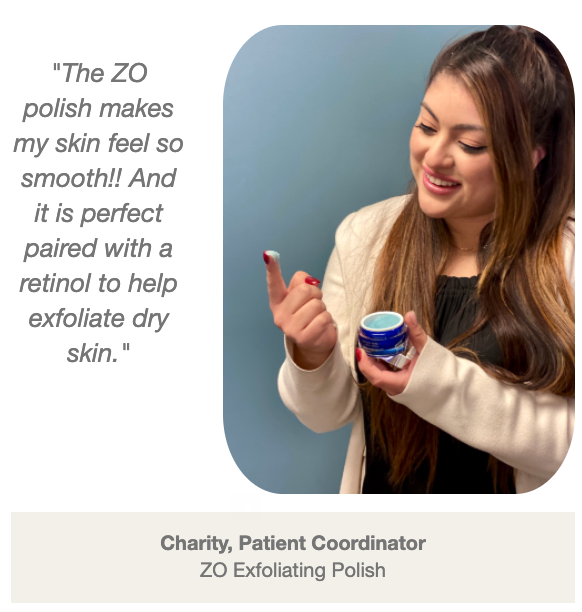
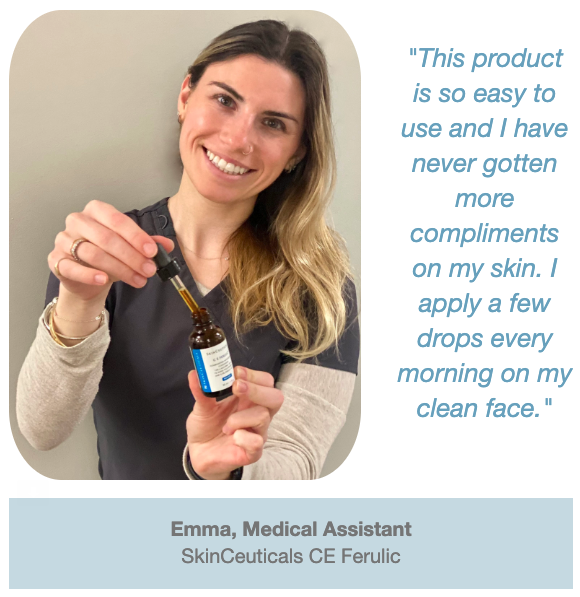
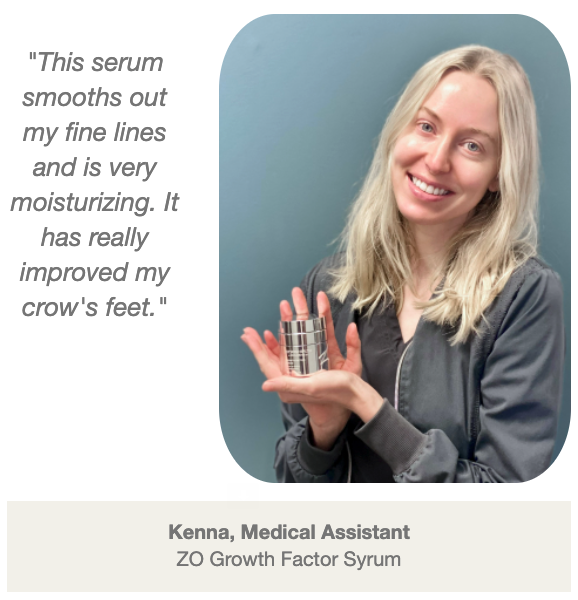
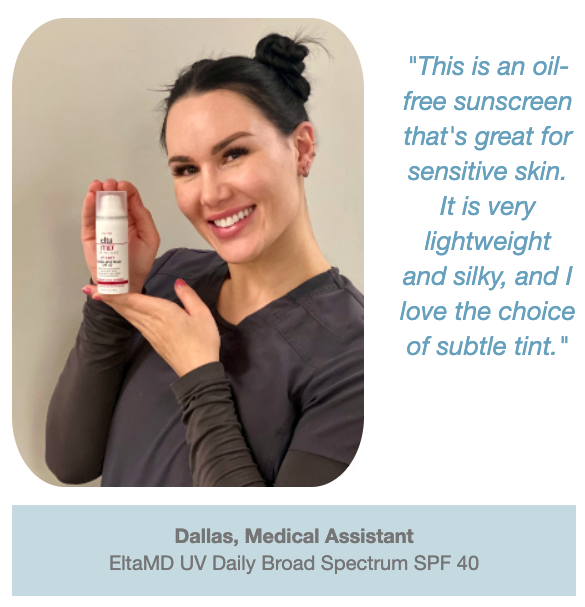
The chin plays a critical role in the balance of facial features. A strong chin can create a greater appearance of strength, symmetry and self-confidence. We offer several options to enhance the size and appearance of your chin.
Placement of a chin implant, also known as chin augmentation, provides definition for the lower face and balances the facial profile. Chin implants are made of various biocompatible materials and are custom-shaped for a natural looking fit. The results are permanent but can be reversed if desired.
Chin implants are used to correct a weak chin or to balance a strong nose. Patients who undergo chin augmentation love their results!
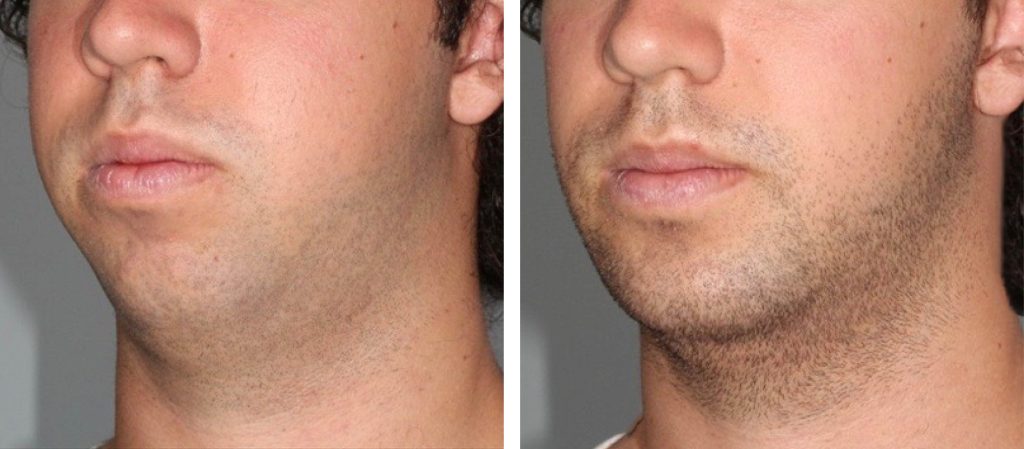
Male Chin augmentation can redefine a jawline and strengthen the chin, creating facial harmony. A sharp, powerful chin is often considered the cornerstone of masculinity.
Dr. Daines and Dr. Madorsky perform chin implant procedures.
Keloid scars can occur after ear piercings. They are typically large raised, firm nodules that occur at the site of the piercing. They can become painful and physically disfiguring.
The cause is thought to be epithelial (skin) entrapment along the piercing tract. This can occur if the piercing gets inflamed or is allowed to seal. Trapped skin proliferates uncontrollably and causes inflammatory scar reaction. Cartilage piercing is particularly sensitive to this complication.
Initial treatment involves injection of steroids into the keloid. If that does not help, injection with a chemotherapy drug such as 5-fluorouracil (5-FU) is done. If that does not work, then surgical removal of the keloid is needed. Re-piercing of the ear can be performed approximately one month after surgery. After re-piercing the ear, it is important to keep the area clean, by cleaning with hydrogen peroxide. Frequent twisting of the earring also keeps the hole open. Most patients do very well after removal and re-piercing of the ear. Rarely, recurrence of the keloid scar may occur. With close follow-up keloids can be prevented with steroid injections.
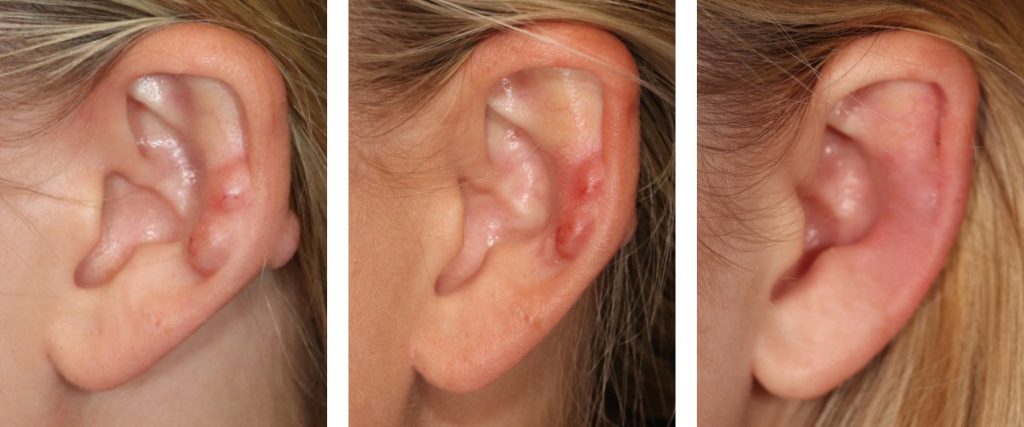
Patient presented with multiple caused by piercings (left). Initial treatment with injection of steroids (center). Ear is seen after surgical removal (right).
Acne is caused by a variety of factors. These factors include increased p. acnes bacteria, increased oil production by oil glands, “clogged pores,” genetic susceptibility, and increased androgen hormones. It is important to target multiple causes of acne to best control it. There are many “tried and true” options and some newer and less well known treatment options.
Initial treatment options for mild to moderate acne focus on consistent application of topical products.
Face washes should contain an active ingredient against acne. Examples include benzoyl peroxide and salicylic acid. After washing the face, topical retinoids are used. Prescription retinoids such as retin-A and tretinoin increase cell turnover and prevent “clogged pores.” Retinoids work best against comedonal acne which refers to whitehead and blackhead acne. Retinoids are a staple of acne management and are also a popular anti-aging product as they improve skin texture and fine lines.
Antibiotics are another cornerstone of acne management- especially inflammatory acne. Inflammatory acne usually appears as red bumps or nodules. Topical and oral antibiotics reduce p. acnes bacteria and reduce inflammation leading to acne lesions. These are usually used in conjunction with topical retinoids.
Hormones contribute to acne because androgens stimulate the oil glands to produce more oil. Oil rich environments allow p. acne bacteria to thrive and cause more acne breakouts. Females who break out during their menstrual cycle or primarily have bumps and nodules along their jawline often respond to hormonal therapies including oral contraceptives and oral spironolactone. Unfortunately, these options are not available to males. However, a new drug, Winlevi, offers a topical antiandrogen option for both males and females.
The ultimate acne treatment is isotretinoin, previously known by a brand name, “Accutane.” Some patients may be nervous about isotretinoin because it is highly regulated due to causing birth defects in pregnant women. However, it is usually well tolerated and is extremely effective at eliminating active acne. Isotretinoin is also the only medication shown to cause long term remission of acne.
The above options can control acne well, but it can be frustrating when there are breakthrough lesions. Some additional options for breakthrough lesions include chemical TCA peels (VIPeels), vascular laser (V-beam laser) treatments, and steroid (kenalog) injections.
VIPeels are a chemical peel that include anti-acne ingredients such as salicylic acid and benzoyl peroxide to promote cell turnover and reduce inflammation and hydroquinone to lighten acne scarring.
V-beam and Kenalog can be used to spot treat a stubborn or inflamed lesion. V-beam is a laser that delivers energy to kill active acne bacteria or treat red scars left behind by previous acne lesions. Kenalog is a steroid that is injected directly into an acne lesion to reduce inflammation. Kenalog is especially useful before a big event because it works quickly, usually reducing a lesion within 24-48 hours. Kenalog is also useful to treat hypertrophic or keloid scars from cystic acne.
With so many options available, it is important to meet with a provider to discuss which option(s) are best for you.
“I’ve got some good news, no more cancer.” Dr. Adam Aronson calmly said to Wade Jackson. A dermatologist and Mohs surgeon, Dr. Aronson confirmed that all cancer had been removed from Wade’s lower eyelid, through the process of Mohs surgery, where layers of skin are removed and viewed under a microscope until cancer cells are no longer present.
Wade was then ushered next door to the SCARS Surgery Center, where oculoplastic surgeon Dr. Justin Karlin reconstructed the eyelid tissue. Although the news was good, it was just one more step in Wade’s years-long dance with skin cancer.
Four years earlier, he was at the SCARS Center having skin cancer removed from his nose, also with Mohs surgery. The deficit was so large that it required an extensive reconstruction by plastic surgeon Dr. Simon Madorsky. Not just one operation, but a multi-stage process was required to rebuild that part of Wade’s nose (see page 3).
When asked what he thinks led to these cancers, Wade is quick to respond. “Well, it was simply a lack of knowledge. Back in the late 60s and 70s, the only time we would apply anything was after we were already burnt to a crisp.” Years of outdoor sports and surfing, and then sun exposure while serving in the US Coast Guard sealed his fate.
“Dr. Madorsky had to perform major reconstruction on my nose, and did so with amazing results. This man is truly an artist.”

Quite a compliment from Wade Jackson, who is himself a professional artist.
When a traumatic brain bleed in 2007 upended his life, Wade was unable to return to the business that he and his family had built. He started to sculpt as a way to get his brain working again. With knowledge of welding from his Coast Guard days, Wade utilized metal and stone as his primary media. A passion for all things aquatic inspires his work. While he still struggles with analytical thinking, the creative side of his brain took off.

By 2013 he had created enough works to sell, and was accepted to the Festival of The Arts in Laguna Beach. “This was my breakout.”
When he met Dr. Madorsky in 2017, little did he know the impact they would have on each other. Over the many months of reconstruction and healing, they developed a connection. “At some point, Simon became a friend,” said Wade.
When it comes to hyaluronic acid injectables (more commonly known as fillers), we tend to focus on areas of volume loss such as the cheeks, under eyes, and lips. The chin is often ignored but can be a great candidate for filler augmentation.
There are several benefits of chin filler including:
- Correction of under-projected chin
- Creating a stronger jawline in men
- Disguising the jowls
- Smoothing of chin dimpling
Chin filler is great for men and women and can be injected into different areas to maintain and/or enhance masculinity and femininity in patients.
The amount of filler needed depends on the chin projection deficit as well as the goal of treatment but can typically range from one to three syringes. Results can last up to two years depending on the type of filler needed.
In the particular patient above, two syringes of Restylane Defyne were used to achieve these beautiful results.
Talk with your provider today to see if chin filler is the right choice for you.
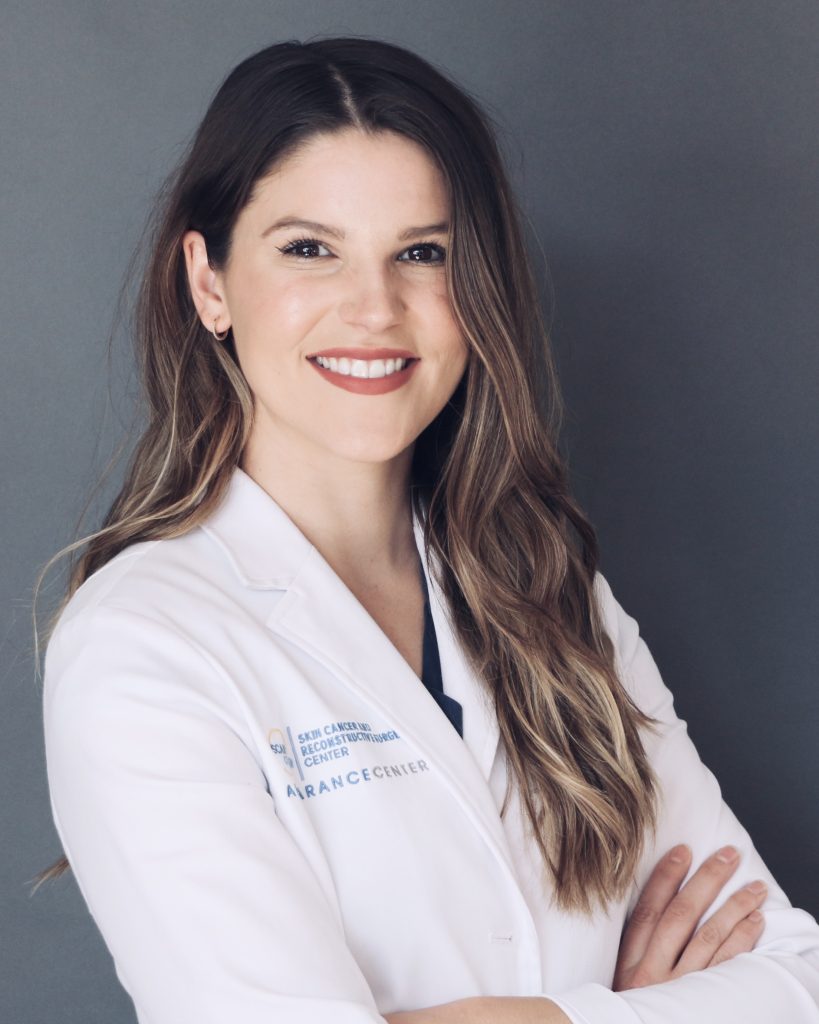
The young woman seen in photos came to our Physician Assistant Shea for a non-surgical chin augmentation. Shea injected her with Restylane Defyne, which is FDA-approved for chin augmentation and correction. This subtle enhancement has huge impact, bringing her face into balance.
“Restylane Defyne is a great alternative for those who prefer nonsurgical treatment options for chin enhancement, or who want to get a glimpse into what a chin augmentation would look like,” says Shea.
Eyelid surgery, or “blepharoplasty,” has become incredibly popular since the pandemic thanks to the “Zoom Boom,” and to increased mask requirements, which make the upper face and eyes a focal point during everyday conversation.
Blepharoplasty is intended to enhance the upper and/or lower lids, to create a more refreshed, youthful look. For the upper lid, the procedure involves making an incision in the natural crease of the eyelid, and then removing and reshaping the skin, muscle, and fat that deflate and droop with age and sun exposure.Blepharoplasty can also be performed on the lower eyelid. As people age, the tissue that holds the fat in place can loosen and the fat can protrude, giving the appearance of bags under the eyes. These bags can be repositioned and reshaped.
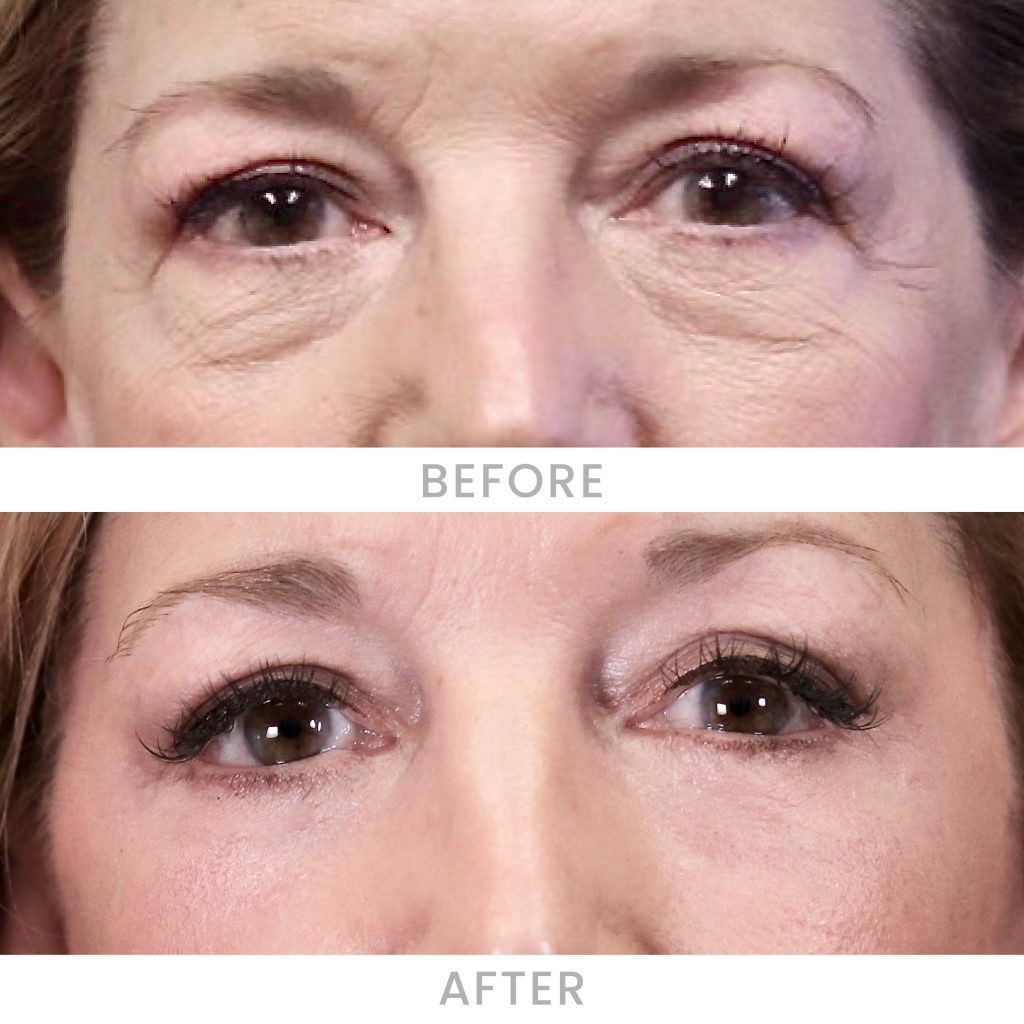
Does insurance cover cosmetic eye procedures?
Generally, cosmetic services are not covered by medical insurance. But in some cases, like the patient shown below, if an eyelid’s drooping is severe and affecting vision, upper eyelid surgery may be covered. Simple tests can determine whether the condition warrants insurance coverage.
Diagnosis: Ptosis
This patient presented with droopy eyelids, also called ptosis (toh-sis), that may occur due to trauma, age, or various medical disorders. Ptosis can affect one or both eyes, and can be present at birth or develop later in life.
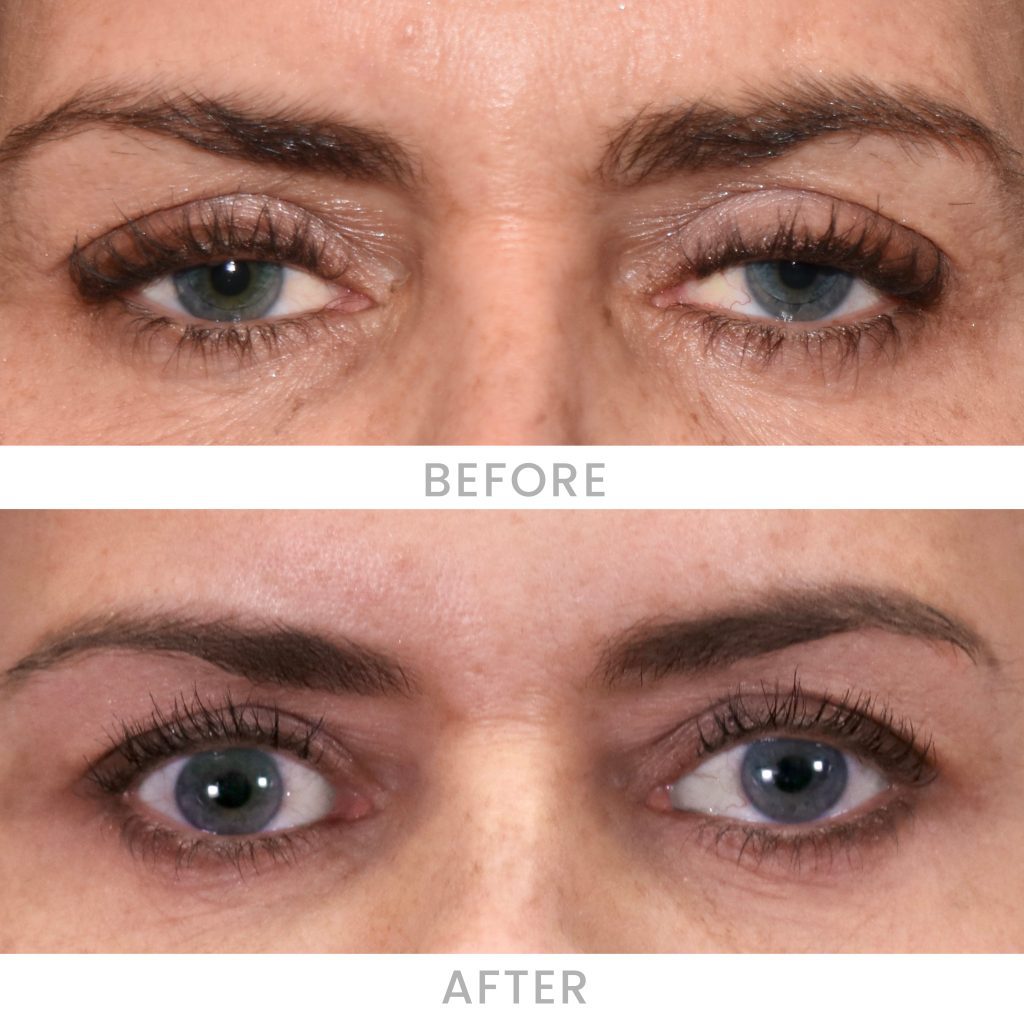
| Depending on the severity of the condition, droopy upper eyelids can block or greatly reduce vision depending on how much it obstructs the pupil. This patient had ptosis repair (covered by insurance) at the same time as an upper blepharoplasty. This was followed by a CO2 laser treatment to the eye area. |
| Dr. Karlin, Dr. Daines, and Dr. Madorsky perform eyelid surgery. Please call our office to schedule an appointment, or use the in our website. |
| Microneedling is a minimally-invasive cosmetic procedure with a short treatment time, minimal downtime, and noticeable improvement within a few days. It is also cost efficient while still providing long-lasting results. It is performed with a hand-held device containing a tip with very tiny needles. This creates micro wounds in the skin, which help to increase the production of collagen and other healing factors. This results in beautifully refreshed skin, smaller pores, a reduction of fine lines and wrinkles, and a more even skin tone. |
| Some of the most common benefits that our patients experience include: • Tighter, lifted skin due to collagen production • Minimized pores • Improvement with fine lines and wrinkles • Reduction of acne scars • Reduction of surgical scarring and stretch marks Microneedling is safe on almost all skin types. To maintain the results of your treatment, you may need multiple sessions and perhaps other complementing treatments. We can advise you on the best plan of action based on your individual goals. |
Dr. Adam Aronson has joined our team! He is a Board Certified Dermatologist with an interest in cosmetic treatments that can compliment and enhance healthy skin.
Dr. Aronson specializes in injectable treatments, dermal fillers, advanced skin care, laser treatments and chemical peels.
Dark circles under the lower eyelidsare common in men and women. Often accompanied by bags, dark circles can make you appear older and tired. Fortunately, there are options to improve the appearance of the undereyes.
What causes dark circles?
There are a number of contributing factors, including
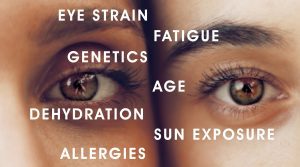
What can be done to address dark circles?
- Injectables/fillers to help replace lost volume and reduce dark shadowing under the eyes (see below).
- Skin care products such as SkinCeuticals A.G.E Eye Complex or the ZO Growth Factor Eye Serum to smooth and brighten the under eye skin. (Available at the Appearance Center.)
- CO2 laser resurfacing to tighten skin and reduce discoloration.
- You may be a candidate for eyelid surgery, also known as blepharoplasty. Speak with one of our surgeons to learn more.
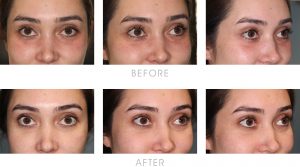
All of our providers are available for injectables. Additionally, our PAs are available for free consultations on skin care, injectables and lasers.
